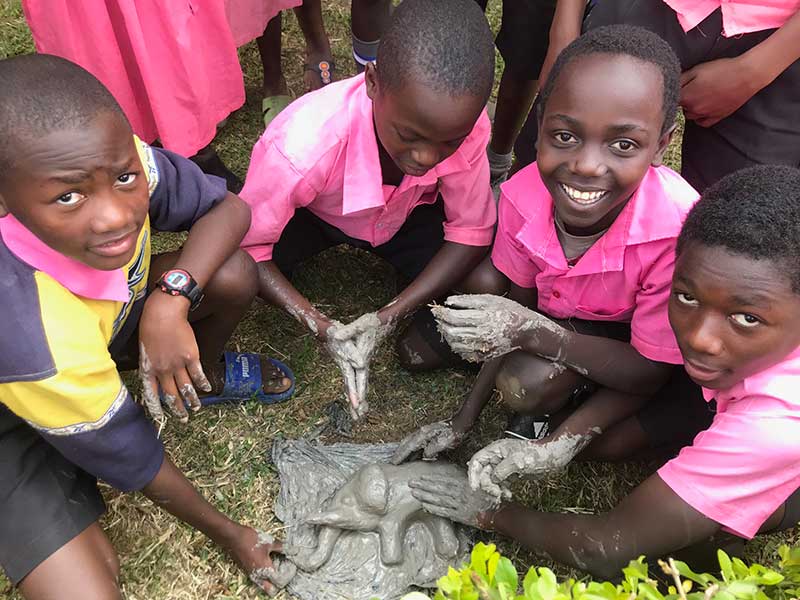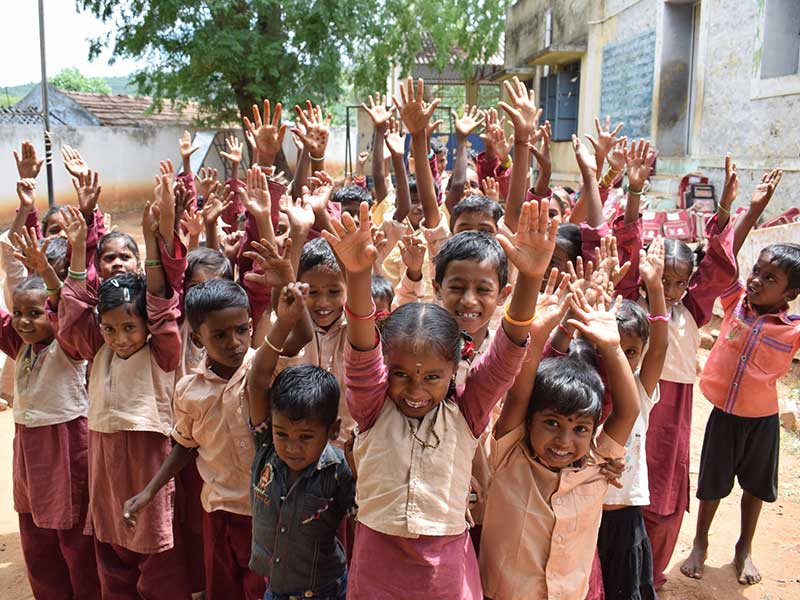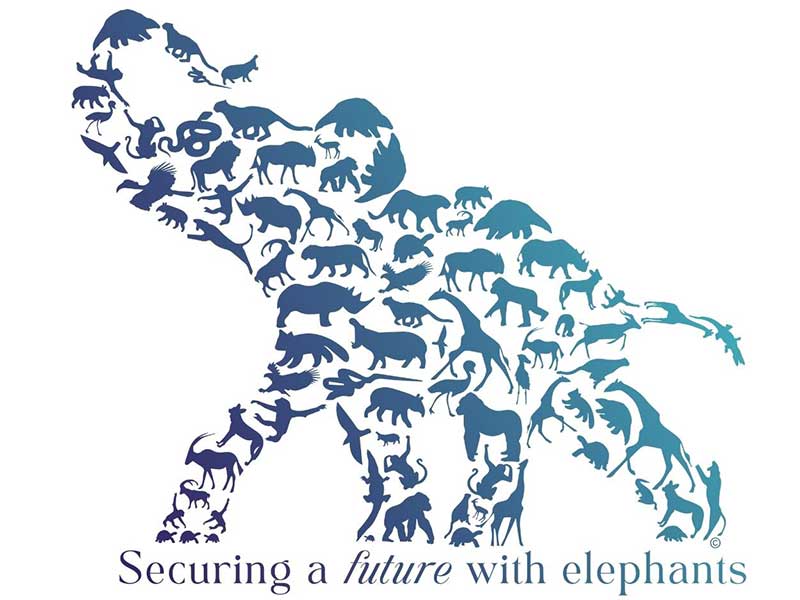
Author: Sarah Conley
International Elephant Foundation
(originally appeared in the Journal of the Elephant Managers Association (JEMA) Volume 33, No. 3. November 2022)
Founded in 1998, the International Elephant Foundation’s (IEF) mission has always been to connect humans with elephants for our mutual benefit. Our founders recognized that conservation cannot just be action that happens far away. In order to inspire people to take action to save elephants we have to find ways to get people invested in their survival. We must bridge the gap between our increasingly disconnected human world and wildlife and by bridging this gap we can save endangered species. That includes providing resources and supporting people who share their landscape with elephants as well as inspiring those of us living outside of range countries to feel connected to animals we may never see in person.
While IEF is focused on elephants, we realize that helping and protecting elephants has a ripple effect for the entire ecosystem protecting everything from the trees to primates to small mammals to the tiny frogs who make habitats out of elephant footprints. Our projects in Uganda helping to secure Queen Elizabeth and Murchison Falls National Parks have helped the recovery of the Rothschild’s giraffe and lion populations. Projects in India and Nepal benefit the greater one-horned rhino and the Bengal tiger. Conservation Response Units throughout Sumatra not only benefit critically endangered Sumatran elephants but Sumatran tiger, Sumatran rhino, tapir, and multiple species of hornbill, to name a few. Many do not realize how far elephants’ protective metaphorical umbrella reaches. Protecting dwindling habitat in Sumatra protects the world’s largest flower the rafflesia. Elephants share habitats with multiple species of pangolin in Asia and Africa. And we have even seen carry-over benefits for gharial populations in Nepal. Clearly, protecting elephants has global benefits.
With our increasingly industrialized world, wildlife habitat often butts up against human settlements and farmland, leading to human-elephant conflict (HEC), which has become the number one problem facing elephants in the fight for survival (even more than poaching for ivory). Protecting elephants often means addressing misconceptions where elephants are the only ones blamed for conflict. We often only discuss human-elephant conflict but it really is just a specific slice of a global environmental problem (e.g. global warming, predicted and real food and water shortages, and the mass extinction of wildlife) that has real and deadly consequences for all involved. Human development projects often do not take into consideration the needs of elephants and other wildlife. We still have not discovered economical and long-term effective mitigation methods, but human populations continue to grow requiring more space to meet demands for food and living space. On top of that, climate change is placing stress on all habitats and all living things, making finding food and water more difficult.
So what are the solutions? Governments have a responsibility to promote wise land use planning, practice responsible stewardship of their nation’s natural resources, and improve the standard of living of their citizens. But in the meantime all of us, including IEF, can work internationally by supporting grassroots efforts like community education, and overall building a community consensus for conservation in range countries, which is key to changing attitudes about elephants and creating sustainable change for the benefit of all wildlife. Bridging the gap between humans and elephants, both domestically and in range countries, to foster community buy-in for projects is essential for effective conservation action. This is why IEF’s conservation philosophy prioritizes community engagement, community stakeholders, and community partnerships.
Community engagement cannot stop at national borders. In order for any conservation work to be sustainable, we need a global community who feels connected to the work being done in the field. Many westerners—like those of us who live in the North America and Europe—consider themselves global citizens yet display little true understanding of the needs and nuances of those who share their homelands with elephants. Those who live in elephant range countries face huge challenges in simply feeding their families and improving their standards of living. Conservationists compassionately understand how one night of crop-raiding can destroy an entire year’s worth of food and income for a farmer, or cause injury or death, resulting in the completely logical response of animosity and even violence towards elephants and wildlife. But this understanding of a complicated situation is not something that is widely shared outside of our circles.
There is very little connection with how many people live in Africa and Asia and how people live in the U.S. and Western Europe. For instance, many Westerners have never experienced living without electricity and running water in their homes let alone lived with a herd of 5-ton animals walking across their property. Living in thatched-roof houses made of sticks and mud or being a subsistence farmer is an unfamiliar or abstract concept to them. The public often believes there is never a reason for killing an elephant regardless of the actions of the elephant, needs of the habitat or protein-starved subsistence communities, or the difference between poachers and legal hunters. This often leads to political campaigns that are counterproductive to the needs of the country or community and ugly extreme rhetoric to shoot poachers on sight. But this simplistic extremism is a fallacy enhanced by the Western lifestyle that removes us from nature and the natural world but provides the disposable income to replace nature with behavior that infantilizes house pets.
The general public is told they can show support for conservation by exerting political pressure and giving financial gifts. But oftentimes these methods of support do not come with an in-depth understanding or balanced view of conservation. Without practical experience upon which to base their opinions, the general public can be very susceptible to emotion-based articles that do not represent fact. Without a true appreciation of what conservation means they can throw their support in the wrong direction or back policy ideas that show a lack of awareness for the problems on the ground. Therefore, to raise support be it political or financial and to help conservation be successful, we must connect the general public, the media, and future generations with wildlife and the conservation needs of range country communities in a meaningful way.
Since global conservation requires a global response, it is critically important that we as elephant experts and conservationists educate that huge segment of the world’s population so that they are informed supporters of effective conservation activities. As a world, we face huge issues like political instability, war, natural disasters, and climate change but just as those issues spark worldwide calls to action, we need to band together and have a worldwide call to action to protect wildlife, habitat, and species. We must teach and find understanding to build a bridge globally. By working together to educate the public we can help shape and focus conservation action to where it is most effective.
So how can keepers, researchers, and those working in the field help? Social media has literally brought conservation work into the hands of everyday people through their smartphones. Together we can teach people about conservation projects, elephant physiology, their roles in habitat, and more with the power of an image or short video and a caption. We can literally educate and inspire conservation action with the click of a button. Something that seems mundane or commonplace to you is incredibly fascinating to someone with only a passing knowledge of wildlife and conservation. Using social media we can connect with the people who are disconnected with wildlife. Tell your story. Don’t trust others to tell it for you where they will add their slant. This is a tool to educate so people understand your day-to-day activities, successes, and your passion for animals, and hopefully they will be inspired to learn more. Yet social media is not enough. It can be dehumanizing as our eyes glaze over scrolling past hundreds of posts a day, right past something of meaning. Just like we don’t remember everything we saw while in a YouTube “rabbit hole”, people don’t remember everything they saw on social media. It is a step towards connectivity but doesn’t do the entire job.
Seeing elephants in person teaches us to care. Whether it is in their range countries on safari or in a zoo or private facility, those are the experiences people remember for the rest of their lives. But not everyone can afford trips abroad, or lives near ambassador elephants. The recent pandemic brought this into focus as forced closures and mandatory distancing cut us off from each other as well as from wildlife. Therefore we at IEF worked to bridge that gap. We started Conservation Chats where we hold live video calls with project leaders in the field where supporters and other interested people can learn directly from the expert, ask questions, and make a meaningful connection to work happening a world away. This creates a sense of community where supporters feel a part of something, and hopefully connect with conservation action on a deeper level.
IEF’s Conservation Chats highlight conservation activities that take into account the circumstances under which people live—an approach that has shown to be more effective, has longevity and resonates with a broad audience across all walks of life. Sessions with project partners sharing experiences about promoting alternative crops that aren’t palatable to elephants, to joining community farmers to assist in night watches, to building low-cost poliwire fencing, to teaching safer grain storage methods can be ways that we educate and engage IEF donors as well as the global community to inspire them to give their financial, political, and other support in order to help communities impacted by elephants feel like their lives are at least as valuable as the lives of wildlife. Elephants and wildlife cannot thrive if the people who vote at the regional and national levels in range countries are not thriving themselves. By bringing attention to projects via Conservation Chats and supporting projects that incorporate this philosophy, IEF is bridging the gap between humans and elephants who live side by side.
The end result of this community approach is to help conservation funds flow into the field. Whether it is with subsistence farmers in Zambia or Indonesia, villages in Nepal, zoogoers in the US, or social media users around the world, taking a community approach to conservation helps elephants. If we can work together to connect humans with elephants, we can bridge the gap and build a world where both thrive.


Photo Captions & Credits:
KFSP_ Elephant Models 2.jpgKibale Forest Schools ProgramChildren enjoying activities from conservation awareness classes and wildlife clubs in Uganda.multispecies graphic blues copyright copy.pngInternational Elephant FoundationProtecting elephants protects countless other species who share their habitats.School children invitin gguest by waving their hands copy.JPGR. MarimuthuSchool children in conflict-prone regions of India show excitement for educational street plays.
| File Name | Photo Credit | Caption |


